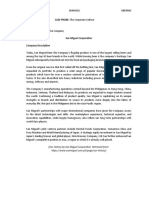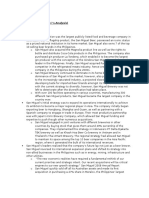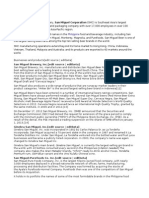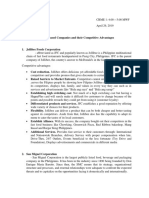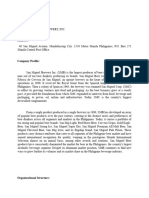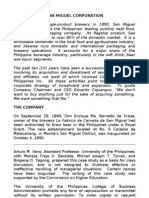0 ratings0% found this document useful (0 votes)
22 viewsEntrepreneur Strategy
Entrepreneur Strategy
Uploaded by
Rameinor TambuliRamon Ang took full control of the San Miguel Corporation (SMC) conglomerate after Eduardo Cojuangco Jr. sold his stake. Under Ang's leadership, SMC grew its products and services portfolio and increased sales. Ang established SMC in 1890 as Southeast Asia's first brewery and within a generation, San Miguel Beer became one of the best-selling beers in the region. SMC has since expanded into food, packaging, power, mining, energy, toll ways and airports. Ang enhanced value through efficiencies, acquisitions, distribution expansion, and integrating production across businesses.
Copyright:
© All Rights Reserved
Available Formats
Download as DOCX, PDF, TXT or read online from Scribd
Entrepreneur Strategy
Entrepreneur Strategy
Uploaded by
Rameinor Tambuli0 ratings0% found this document useful (0 votes)
22 views1 pageRamon Ang took full control of the San Miguel Corporation (SMC) conglomerate after Eduardo Cojuangco Jr. sold his stake. Under Ang's leadership, SMC grew its products and services portfolio and increased sales. Ang established SMC in 1890 as Southeast Asia's first brewery and within a generation, San Miguel Beer became one of the best-selling beers in the region. SMC has since expanded into food, packaging, power, mining, energy, toll ways and airports. Ang enhanced value through efficiencies, acquisitions, distribution expansion, and integrating production across businesses.
Original Title
Entrepreneur Strategy.docx
Copyright
© © All Rights Reserved
Available Formats
DOCX, PDF, TXT or read online from Scribd
Share this document
Did you find this document useful?
Is this content inappropriate?
Ramon Ang took full control of the San Miguel Corporation (SMC) conglomerate after Eduardo Cojuangco Jr. sold his stake. Under Ang's leadership, SMC grew its products and services portfolio and increased sales. Ang established SMC in 1890 as Southeast Asia's first brewery and within a generation, San Miguel Beer became one of the best-selling beers in the region. SMC has since expanded into food, packaging, power, mining, energy, toll ways and airports. Ang enhanced value through efficiencies, acquisitions, distribution expansion, and integrating production across businesses.
Copyright:
© All Rights Reserved
Available Formats
Download as DOCX, PDF, TXT or read online from Scribd
Download as docx, pdf, or txt
0 ratings0% found this document useful (0 votes)
22 views1 pageEntrepreneur Strategy
Entrepreneur Strategy
Uploaded by
Rameinor TambuliRamon Ang took full control of the San Miguel Corporation (SMC) conglomerate after Eduardo Cojuangco Jr. sold his stake. Under Ang's leadership, SMC grew its products and services portfolio and increased sales. Ang established SMC in 1890 as Southeast Asia's first brewery and within a generation, San Miguel Beer became one of the best-selling beers in the region. SMC has since expanded into food, packaging, power, mining, energy, toll ways and airports. Ang enhanced value through efficiencies, acquisitions, distribution expansion, and integrating production across businesses.
Copyright:
© All Rights Reserved
Available Formats
Download as DOCX, PDF, TXT or read online from Scribd
Download as docx, pdf, or txt
You are on page 1of 1
RODA, ANGEILYN S.
BSA 1
Entrepreneur : RAMON S. ANG
Strategy : GROW PRODUCTS-SERVICES PORTFOLIO AND TO INCREASE SALES
Execution : Took full control of conglomerate San Miguel Corp. (SMC) after its
chair, Eduardo Cojuangco Jr., sold a huge chunk of his stake in the diversified firm
to his hard-charging protégé. Established in 1890, La Fabrica de Cerveza de San
Miguel, Southeast Asia’s first brewery produced and bottled what would
eventually become one of the bestselling beers in the region. Within the span of a
generation, San Miguel Beer would become an icon among beer drinkers. Today,
San Miguel Beer–the Company’s flagship product–is one of the largest selling
beers and among the top 10 beer brands in the world. While brewing beer is the
company’s heritage, San Miguel subsequently branched out into the food and
packaging businesses. From the original cerveza that first rolled off the bottling
line, San Miguel Corporation has since expanded its portfolio to produce a wide
range of popular beverage, food and packaging products which have–for over a
century–catered to generations of consumers’ ever changing tastes. It has also
diversified into heavy industries including power and other utilities, mining,
energy, toll ways and airports. San Miguel enhances the value of their
established businesses, ever striving to achieve even greater efficiencies
and operational excellence, continue to seek strategic acquisition and
greenfield opportunities, positioning their businesses in a way to best
contribute to their country’s economic growth and industrial development,
create an even broader distribution network for their products and expand
their customer base by identifying synergies across their various
businesses. In addition, they are pursuing plans to integrate their
production and distribution facilities for its both their established and newly
acquired businesses to generate additional cost savings and efficiencies.
You might also like
- Production and Operations Improvement Plan (POIP) : Manufaturing Business (Corporation Type)Document30 pagesProduction and Operations Improvement Plan (POIP) : Manufaturing Business (Corporation Type)nikNo ratings yet
- Swot San Miguel CorporationDocument26 pagesSwot San Miguel CorporationMAG MAGNo ratings yet
- Financial Analysis 2Document25 pagesFinancial Analysis 2Chin FiguraNo ratings yet
- History of San Miguel Corporation Proud BeginningsDocument2 pagesHistory of San Miguel Corporation Proud BeginningsNephtali SelocremNo ratings yet
- History of San Miguel CorporationDocument2 pagesHistory of San Miguel CorporationNephtali SelocremNo ratings yet
- San Miguel CorporationDocument5 pagesSan Miguel CorporationKrizza Caryl GallardoNo ratings yet
- SCRIPT San Miguel CorporationDocument7 pagesSCRIPT San Miguel Corporationlowi shooNo ratings yet
- Corporate Level Strategy - SMCDocument5 pagesCorporate Level Strategy - SMCChelsea Sabado100% (4)
- Who We Are: Mary Jane Q. Briones Financial ManagementDocument10 pagesWho We Are: Mary Jane Q. Briones Financial ManagementJohn DoehNo ratings yet
- Part I Company: Our VisionDocument18 pagesPart I Company: Our VisionJeucer Monta0% (1)
- Group 5 ABM 11-4 San Miguel Corporation: HistoryDocument3 pagesGroup 5 ABM 11-4 San Miguel Corporation: HistoryFatimah M. PintoNo ratings yet
- Module 2.1 ConworlDocument2 pagesModule 2.1 ConworlAngel UntalanNo ratings yet
- Contemp M2Document7 pagesContemp M2Fritz ReyesNo ratings yet
- San Miguel Corporation Case AnalysisDocument5 pagesSan Miguel Corporation Case AnalysisJcel JcelNo ratings yet
- TaskDocument2 pagesTaskJessabell Delos SantosNo ratings yet
- SummaryDocument4 pagesSummaryMerianne CaabayNo ratings yet
- San Miguel Corporation Case AnalysisDocument5 pagesSan Miguel Corporation Case AnalysisGenesis lumabaoNo ratings yet
- G6 San Miguel Corporation PDFDocument33 pagesG6 San Miguel Corporation PDFlowi shooNo ratings yet
- San Miguel CorporationDocument10 pagesSan Miguel CorporationMichelleDelaguna0% (1)
- Group 4 San Miguel Corporation Case AnalysisDocument28 pagesGroup 4 San Miguel Corporation Case Analysislowi shooNo ratings yet
- What Products Does San Miguel Corporation OfferDocument4 pagesWhat Products Does San Miguel Corporation OfferRaindel Carl OlofernesNo ratings yet
- A6 Gbermic FerreraDocument3 pagesA6 Gbermic Ferreramark florence B BrunoNo ratings yet
- San Miguel DraftDocument7 pagesSan Miguel DraftKristen IjacoNo ratings yet
- FInal ... San Miguel CorporationDocument14 pagesFInal ... San Miguel CorporationNesaNo ratings yet
- SMC CSR ProgramsDocument90 pagesSMC CSR ProgramsChristine SeriosaNo ratings yet
- Situation Analysis For San Miguel CorporationDocument3 pagesSituation Analysis For San Miguel CorporationJiego Tanchanco88% (8)
- Multinational CompaniesDocument3 pagesMultinational CompaniesKellNo ratings yet
- Group - 5Document4 pagesGroup - 5JoyNo ratings yet
- San Miguel CorporationDocument19 pagesSan Miguel CorporationRoselynNo ratings yet
- San Miguel CorporationDocument22 pagesSan Miguel CorporationMikee ValbaresNo ratings yet
- Exploring San Miguel Corporation SWOT AnalysisDocument10 pagesExploring San Miguel Corporation SWOT Analysisstephen.espinasNo ratings yet
- CASE-STUDY_BA3EDocument17 pagesCASE-STUDY_BA3Echerrylynvallez438No ratings yet
- San Miguel Corporation Company BackgroundDocument18 pagesSan Miguel Corporation Company BackgroundRamirez Mark IreneaNo ratings yet
- San Miguel CorporationDocument3 pagesSan Miguel Corporationmark_torreonNo ratings yet
- San MIguel Case Study FinalDocument31 pagesSan MIguel Case Study FinalMj Gutierrez74% (19)
- Cañete Midterm ExamDocument4 pagesCañete Midterm ExamPark WangjaNo ratings yet
- San Miguel CorporationDocument31 pagesSan Miguel CorporationDrey AgazaNo ratings yet
- Final SMCDocument33 pagesFinal SMCMelody AgdigosNo ratings yet
- San MiguelDocument11 pagesSan MiguelNeric Ico MagleoNo ratings yet
- Backus TG2Document27 pagesBackus TG2Diana Aguilar Alata100% (1)
- Case SMCDocument2 pagesCase SMCMaridel LigsonNo ratings yet
- San Miguel Corporation Written ReportDocument14 pagesSan Miguel Corporation Written ReportLama Grace Ignacio CaidoyNo ratings yet
- San Miguel CorporationDocument7 pagesSan Miguel Corporationpaopao333078% (9)
- Jollibee: HistoryDocument10 pagesJollibee: HistoryDodi TeodoroNo ratings yet
- San Miguel 2019 FSDocument176 pagesSan Miguel 2019 FSsninaricaNo ratings yet
- SMC Company Profile Revised FinalDocument1 pageSMC Company Profile Revised FinalAldrin CabangbangNo ratings yet
- Outline With RevisionsDocument20 pagesOutline With RevisionsJPIA MSU-IITNo ratings yet
- Competitive Advantage of Philippine Based CompaniesDocument3 pagesCompetitive Advantage of Philippine Based Companiesjedz antonio50% (6)
- Good Governance and Social ResponsibilityDocument19 pagesGood Governance and Social ResponsibilityNeil Ross SantiagoNo ratings yet
- SMC Company ProfileDocument2 pagesSMC Company ProfileAldrin CabangbangNo ratings yet
- San Miguel Corporation: Learning About A BusinessDocument55 pagesSan Miguel Corporation: Learning About A BusinessLyka mae LabadanNo ratings yet
- Name of The CompanyDocument9 pagesName of The CompanyLANDAR, CONNARD B.No ratings yet
- San Miguel CorporationDocument17 pagesSan Miguel CorporationAliza Peri Ü ÜNo ratings yet
- Karla Jiménez 23-0694 3 - CompressedDocument14 pagesKarla Jiménez 23-0694 3 - Compressedkj23-0694No ratings yet
- Case Study San Miguel CorporationDocument64 pagesCase Study San Miguel CorporationNhoj KramNo ratings yet
- Case Study San Miguel CorporationDocument6 pagesCase Study San Miguel CorporationJeannes Espina100% (1)
- Coca Cola Vs PepsiDocument17 pagesCoca Cola Vs PepsiVijay KumarNo ratings yet
- Indian SpicesDocument64 pagesIndian SpicesIfrah Khan100% (1)
- Global Brand Power: Leveraging Branding for Long-Term GrowthFrom EverandGlobal Brand Power: Leveraging Branding for Long-Term GrowthRating: 5 out of 5 stars5/5 (1)
- Cadbury's Purple Reign: The Story Behind Chocolate's Best-Loved BrandFrom EverandCadbury's Purple Reign: The Story Behind Chocolate's Best-Loved BrandRating: 5 out of 5 stars5/5 (1)
- Nature and Form of The ContractDocument17 pagesNature and Form of The ContractRameinor TambuliNo ratings yet
- Chapter 6 - Financial Statement AnalysisDocument22 pagesChapter 6 - Financial Statement AnalysisRameinor TambuliNo ratings yet
- CHAPTER 11 - AnswerDocument16 pagesCHAPTER 11 - Answernash100% (1)
- Chapter 13 - AnswerDocument3 pagesChapter 13 - Answerwynellamae100% (1)
- What Is Art: Introduction and Assumptions: The Role of Creativity in Art MakingDocument3 pagesWhat Is Art: Introduction and Assumptions: The Role of Creativity in Art MakingRameinor TambuliNo ratings yet
- PART 1-WACC Part-: (7 Points Each)Document2 pagesPART 1-WACC Part-: (7 Points Each)Rameinor TambuliNo ratings yet
- Roda, Angeilyn S. Bsa 1: Entrepreneur: LANCE GOKONGWEI Strategy: Grow Sales From New Products ExecutionDocument1 pageRoda, Angeilyn S. Bsa 1: Entrepreneur: LANCE GOKONGWEI Strategy: Grow Sales From New Products ExecutionRameinor TambuliNo ratings yet
- Midterm Examination Gen Principles and Tax RemediesDocument3 pagesMidterm Examination Gen Principles and Tax RemediesRameinor Tambuli100% (1)
- Roda, Angeilyn S. Bsa 1 Entrepreneur: Forest Xiaodong Li Strategy: Sell More Products To Market Execution: FoundedDocument1 pageRoda, Angeilyn S. Bsa 1 Entrepreneur: Forest Xiaodong Li Strategy: Sell More Products To Market Execution: FoundedRameinor TambuliNo ratings yet
- Business StrategyDocument1 pageBusiness StrategyRameinor TambuliNo ratings yet
- Ethics PDFDocument16 pagesEthics PDFRameinor TambuliNo ratings yet





















